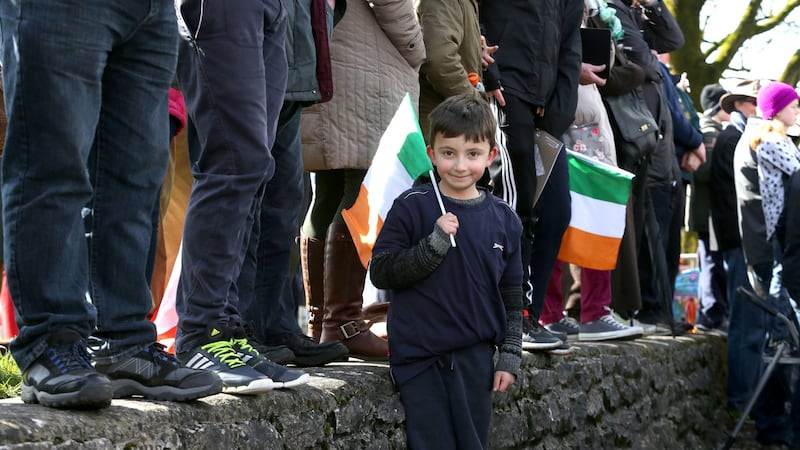The first shots were not fired in the west until Easter Tuesday, but the role played by Galway rebels who held the largest territory outside of Dublin was recalled at Easter Monday's 1916 centenary at Athenry Castle.
Minister for Education Jan O’Sullivan led the wreath-laying ceremony- timed to coincide with similar State events in Dublin, Cork, Ashbourne, Co Meath, and Enniscorthy, Co Wexford – marking the start of the Rising in 1916.
In bright sunshine, several thousand people witnessed Ms O'Sullivan and Galway county cathaoirleach Peter Roche unveil a commemorative sculpture by Gort artist Jethro Sheen, entitled Macnamh which depicts Cúchulainn.

Athenry tidy town volunteers had laboured over the weekend to prepare the venue, which was focal point for the insurrection based around Clarenbridge, Oranmore and the Department of Agriculture's "model farm" – now the Teagasc campus.
Up to 700 Irish Volunteers were "poorly armed" with as many hayforks and pikes among the rifles, revolvers and shotguns, but the county never surrendered, and 38-year-old Constable Patrick Whelan of Eglinton Street barracks was the sole fatality.
When the HMS Laburnum began firing from Galway Bay, leader Liam Mellows led a retreat to Moyode Castle – with eventual disbandment at Limepark at the end of the week.
James Ward, grandson of Mellows's driver of the same name, was among relatives at the event, as was Patrick Howley, son of Peter Howley of Limepark.
Brian Quinn, grandson of Mary Anne Rooney of Cumann na mBan, was also present, as was Lily Walsh, daughter of Irish Volunteer Pat Walsh of Carnmore.
Active and retired members of the Defence Forces from Dún Uí Mhaoilíosa barracks, named after Mellows, in Renmore, participated in the programme drawn up Galway county secretary Michael Owens and Galway GAA chairman and former Fianna Fáil TD Noel Treacy.
Fences
Although fences, security and large screen relay equipment hampered the actual view, the good-humoured crowd gave one of the loudest cheers for uilleann piper Ger Fahy, who played the haunting Gealadh an Lae (New Dawn).
Commdt Frank Flannery read the Proclamation, and Cpl Joseph Hession played the Piper's Lament , followed by the Last Post with Sgt Michael McLoughlin and Sgt David Colgan and the raising of the Tricolour by Lt Seamus Shannon.
The national anthem was played by St Patrick's Brass band, and there were some gasps and laughs when one sole plane marked the Air Corps "fly-past".
Earlier, Patrick Pearse's spiritual retreat at Ros Muc in Connemara was venue for a live broadcast by Raidió na Gaeltachta's current affairs programme Adhmhaidin, which relayed a special address by President Michael D Higgins.
Galway teacher Deirbhile Ní Bhrolcháin, one of the programme's guests, brought a piece of a Mauser gun from the original Asgard. The weapon was one of two kept by her grandfather, Pádraig Ó Brolcháín, who cycled to Howth to help with the landing. His wife Máire Ní Chillín had once taught Irish to Maud Gonne.
Historians Prof Gearóid Ó Tuathaigh of NUIG and Cormac Ó Comhraí , author of the recently published Sa Bhearna Bhaoil: Gaillimh 1913-1923, were contributors, as was journalist Seosamh Ó Cuaig, related to Irish Volunteer Colm Ó Gaora and Fearghas Mac Lochlainn, great grand-nephew of Pearse.
Mr Ó Cuaig had organised a commemorative cycle from Ros Muc to Liam Mellows’s headquarters in the east Galway village of Killeeneen at the weekend - marking a bike dash by Ó Gaora in 1916.
Mr MacLochlainn, who read the Proclamation on air, is principal of Scoil Sailearna in Indreabhán, where an art installation by Dara McGee currently depicts seven life-size depictions of the Proclamation signatories. Local builder Liam O’Doherty provided the materials, and the exhibition will remain in situ for some weeks.
A new interpretative centre, Culturlann Chonamara, is being built by State agencies close to the Pearse cottage at an Aill Mhór, which he acquired in 1909 and last visited in 1915.








